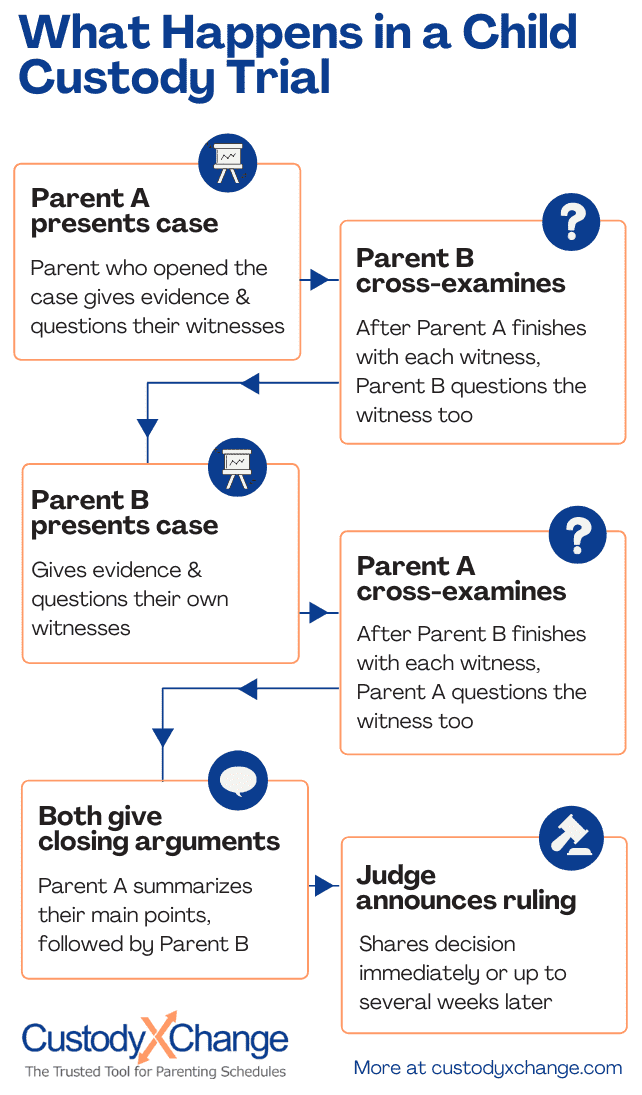Family Law Trials in British Columbia
If separated parents can't agree on how to parent apart despite attempts to negotiate, they ultimately go to trial.
During the trial, each parent shows the judge evidence of why they should get what they've asked for. Then, the judge makes a final order.
Only Supreme Court can hold trials for divorce and property division. Both Supreme and Provincial courts can hold trials for guardianship, parental responsibilities, parenting time, child support and nonparental contact with a child.
Preparing for trial
Preparation is essential when going to trial. If you have a lawyer, they will help you get ready. Otherwise, you can get help through a legal aid organization or prepare on your own.
Gathering evidence
Evidence is meant to back up your claims. It comes in the forms of exhibits and witnesses.
Exhibits can include:
- A proposed parenting plan
- Photos and videos
- Expert reports
- Criminal records
- Printouts of messages between parents
- And more
Before the trial, you'll give copies of your exhibits to the court and the other parent. Review the Provincial Court Family Law Rules and the Supreme Court Family Law Rules to find exact deadlines. Bring the original exhibit (if you have it) and three copies with you to the trial.
Witnesses testify to the firsthand knowledge they have. Firsthand knowledge is anything the witness saw, heard or did themselves. Each parent is a witness.
If a witness works for the government or might not agree to testify, you should subpoena them (i.e., force them to appear in court). Use the Provincial Court Subpoena or Supreme Court Subpoena.
Judges typically require live witness testimony, but in some cases they may allow a witness to testify via a sworn written affidavit.
Submitting financial documents
If your trial involves spousal or child support, each parent must submit a financial statement to the court and give a copy to the other parent.
Fill out the form for your court: Provincial Court Financial Statement or Supreme Court Financial Statement. Then, sign it in front of a commissioner for taking affidavits. Bring a photo ID. Afterward, you cannot alter the document.
Preparing your opening and closing statements
Write your opening and closing statements before the trial so you know what to say in court.
The opening statement should give a basic overview of your case. This can include what you're asking for, a brief preview of the evidence you'll present and the witnesses you'll call.
The closing statement should summarize the main points of your case. If your case is complex, the judge may ask you to provide this in writing.
Trial proceedings
If you have a lawyer, they will present your case for you. If not, you'll handle everything on your own. The judge may simplify the process if neither parent has a lawyer.
In Provincial Court, the parent who started the case is called the applicant; in Supreme Court, they're the claimant. We use applicant below.
In both courts, the other parent is called the respondent.

Before you speak, the judge will ask you to state your name, title (e.g., Mrs., Mr.) and preferred pronouns so they know how to address you.
Often, you'll spend the first half of the day or so discussing the possibility of settlement. If there's no settlement, the trial will progress as usual.
To begin, both parents give opening statements.
Then, the applicant takes the stand as the first witness to tell their version of events.
After, they question their witnesses. They can provide the witnesses with exhibits that support the topics being discussed.
The respondent gets to cross-examine each of the applicant's witnesses (question them to challenge or discredit them), and the applicant has an opportunity to redirect afterward (question those witnesses again to clarify points from cross-examination).
The above process repeats when the respondent presents their case — but with the respondent taking the stand and calling their own witnesses.
Afterward, in Supreme Court, the applicant may get to call rebuttal witnesses. These witnesses can only speak about new information from the other side's testimony.
The trial ends with each parent making a closing statement. The applicant goes first.
After a trial
It can take up to six months to get final orders from the judge. In the meantime, you'll follow your interim orders or the routine you have.
Once you get the judge's decision, you have 30 days to appeal if your trial was in Supreme Court, and 40 days to appeal if your trial was in Provincial Court. You can only appeal if there was a legal error, and you generally cannot provide new facts or evidence during the appeals process.
Staying organized when you go to trial
Going to trial over parental responsibilities and parenting time requires serious organization.
You'll need to present evidence, which could range from messages with the other parent to a calendar showing when you care for your child. You should also present a proposed parenting plan and schedule to the court.
The Custody X Change app lets you create and manage all of these elements in one place.

You can customize this to fit your situation with Custody X Change.
With parent-to-parent messaging, personalized custody calendars, a parenting plan template and more, Custody X Change makes sure you're prepared not only for trial but for every step of your case.
Take advantage of our technology to get what's best for your child.
